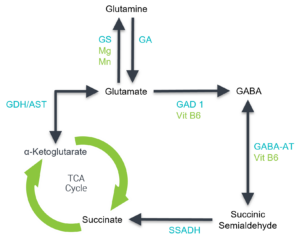WHAT IS GLUTAMATE?
Involved in nearly every major excitatory brain function, glutamate is the primary and most abundant excitatory neurotransmitter in the central nervous system, and one of the most critical of all neurotransmitters. It’s estimated that more than half of all neural synapses release glutamate, thus making glutamate the principal neurotransmitter for use in neural circuit communication.
Glutamate is interchangeable with glutamic acid. The two are nearly identical, the only difference being that glutamic acid has an extra proton (i.e., an extra hydrogen atom). Under physiological conditions, glutamic acid loses a proton, and this form of the amino acid is known as glutamate. The glutamate form is the form that is abundant in the human body.
WHAT DOES GLUTAMATE DO?
Glutamate is an excitatory neurotransmitter, critical for healthy brain and nervous system function. Glutamate makes it possible to learn, remember, feel, sense, and coordinate movements.
Excitatory neurotransmitters activate the next neuron in a chemical message chain, making sure the signal (known as an action potential or a nerve impulse) continues. Action potentials are how neurons communicate, and excitatory neurotransmitters facilitate that communication. Should there not be sufficient quantities of glutamate to trigger an action potential, the chemical message will not continue.
Glutamate is also the amino acid precursor for its counterpart, the inhibitory neurotransmitter GABA (gamma-aminobutyric acid), and the body’s most abundant amino acid.1
Glutamate is an important building block for proteins in the body. It is important for nutrition and metabolism. Glutamate, as glutamic acid, is one part of the “master antioxidant” tri-peptide glutathione. Glutamate interaction with specific taste cells in the tongue is a major component of umami taste.2
HOW ARE GLUTAMATE AND GABA RELATED?
Glutamate and GABA levels go hand in hand because GABA is produced from glutamate with the help of vitamin B6. Glutamate’s excitatory effects are balanced by the inhibitory effects of GABA. Where glutamate increases the likelihood of an action potential, GABA decreases it.
The balance between inhibitory neuronal transmission via GABA and excitatory neuronal transmission via glutamate is essential for proper cell membrane stability and neurologic function.3
HOW IS GLUTAMATE MADE?
Glutamate is synthesized from glutamine via the glutamate-glutamine cycle.4
In the pre-synaptic neuron, glutamine is converted into glutamate by phosphate-activated glutaminase (GA). That glutamate is stored in synaptic vesicles until it is released into the synapse.
Glutamate that has been released into the synaptic cleft will ultimately be taken up by astrocytes, a type of glial cell, which are support cells of the central and peripheral nervous systems.
The astrocytes convert glutamate into glutamine using the enzyme glutamine synthetase (GS) with the help of mineral cofactors magnesium and manganese. Glutamine will eventually make it back to the neuron where it can be converted into glutamate, thus starting the cycle all over again.5
 Glutamate Pathway. Glutamate is synthesized from either glutamine or alpha-ketoglutarate made by the TCA cycle. Enzymes GS: Glutamine Synthetase, GA: Glutaminase, GAD 1: Glutamate Decarboxylase, GABA-AT: GABA Aminotransferase, SSADH: Succinate Semialdehyde Dehydrogenase, GDH: Glutamate dehydrogenase, AST: Aspartate transaminase Cofactors Mg: Magnesium, Mn: Magnanese, Vit: Vitamin
Glutamate Pathway. Glutamate is synthesized from either glutamine or alpha-ketoglutarate made by the TCA cycle. Enzymes GS: Glutamine Synthetase, GA: Glutaminase, GAD 1: Glutamate Decarboxylase, GABA-AT: GABA Aminotransferase, SSADH: Succinate Semialdehyde Dehydrogenase, GDH: Glutamate dehydrogenase, AST: Aspartate transaminase Cofactors Mg: Magnesium, Mn: Magnanese, Vit: Vitamin
WHERE IS GLUTAMATE FOUND IN THE BODY?
As the central nervous system’s most abundant and critical excitatory neurotransmitter, glutamate is found throughout the brain and spinal cord in neurons and glia, and is present in over 90% of synapses.6
Glutamate is also a non-essential amino acid that is present in all protein-containing foods, but ingested glutamate has no association with glutamate circulating in the brain. Glutamate from high glutamate foods cannot cross the blood-brain barrier,7 and upon ingestion, is quickly metabolized as oxidative fuel for the intestinal lining.26
Note: The blood-brain barrier (BBB) is the specialized system of brain microvascular endothelial cells that shields the brain from toxic substances in the blood, supplies brain tissues with nutrients, and filters harmful compounds from the brain back to the bloodstream.8
WHAT DOES GLUTAMATE DO IN THE BRAIN?
As the main molecule promoting neuronal excitation, glutamate is the principal mediator of cognition, emotions, learning, sensory information, and motor coordination, and is linked to the activity of most other neurotransmitter systems (e.g., dopamine, serotonin, .).9,10
Central Nervous System Function
Glutamate is responsible for the majority of excitatory chemical messages that are sent between nerve cells.
Learning and Memory
Glutamate plays a critical role in long-term potentiation (LTP), the main form of synaptic plasticity, which represents a cellular correlate of learning and memory.11,12 In other words, glutamate allows nerve cells to connect associated information, which is the foundation of memory.9 Our brain does not create new neurons to store new memories, it strengthens connections between existing neurons to store new memories: this is long-term potentiation (LTP).
Energy Source for the Brain
When glucose levels are low, the brain can use glutamate as a reserve energy source.
Mediator of Sleep and Wakefulness
Glutamate levels are high when you’re awake and during the REM (rapid eye movement) phase of sleep.13 One exception is in the thalamus, where levels are highest during non-REM sleep.
Pain
Higher levels of glutamate are associated with an increase in pain levels.
Glutamate as a GABA Precursor
Glutamate is the metabolic precursor for GABA. As the main inhibitory neurotransmitter in the central nervous system, GABA is critical for counteracting glutamate’s excitatory effects.
WHAT HAPPENS WHEN GLUTAMATE IS OUT OF BALANCE?
Glutamate levels are very tightly controlled. Too little glutamate, and neural impulses will be slow, resulting in trouble concentrating and a feeling of mental exhaustion.9
Too much glutamate becomes excitotoxic. Excessive activation of glutamate receptors – caused by prolonged exposure to high glutamate levels – can lead to the activation of cell death pathways, resulting in excitotoxic neurodegeneration and apoptosis (aka “cell death”).14 High glutamate is associated with conditions of brain cell death or neurodegenerative diseases.
Some conditions are also believed to be associated with the brain having low glutamate levels:
- Behavioral or social difficulties
- Confusion and disorientation
- Low mood
- Nervousness
- Obsessional thoughts
HOW DOES GLUTAMATE BECOME IMBALANCED?
Glutamate is an amino acid. If amino acid levels are imbalanced, glutamine, glutamate, and GABA levels could be affected. Although glutamate is non-essential, meaning the body can produce glutamate from other sources, amino acid precursors such as glutamine are needed to make glutamate.
Low levels of cofactors involved in glutamate metabolism (such as magnesium, manganese, and vitamin B6) could lead to imbalanced glutamate levels.
Glutamate and glutamine are used in high quantities by the body. Illness (such as a burn) could deplete tissue levels and lead to imbalances of glutamate.
Injuries to the brain can cause an imbalance between glutamate and GABA function, resulting in excitotoxicity.27
Neuroinflammation has also been shown to imbalance the important glutamate/GABA relationship.28
HOW CAN YOU IDENTIFY GLUTAMATE IMBALANCES?
The neurotransmitter urine test performed by NeuroLab® utilizes state of the art Ultra-high Performance Liquid Chromatography (UHPLC) coupled with Triple Quadruple Mass Spectrometry (QQQ-MS), which provides the highest level of sensitivity and specificity for neurotransmitter testing available anywhere.
Standard high-pressure liquid chromatography (HPLC) measures its detection limit in billionths of a gram. The detection limit for NeuroLab®’s technology is measured in the trillionths of a gram.15
A simple test kit shipped from NeuroLab® can offer an accurate snapshot of brain chemistry without any need of a needle or even having to leave the home.
How Can You Naturally Support Glutamate ?
Supplements may improve glutamate levels, optimize the metabolism of glutamate, or protect neurons from binding high levels of glutamate. Also, exercise has been shown to boost glutamate levels.30
Vitamins, Minerals, and Other Nutritional Supplements
Vitamins B3, B6, magnesium, and manganese are involved in the metabolism of glutamate. Imbalanced levels of glutamate, GABA, or glutamine may be a sign that these cofactors are needed. Vitamin B3 (niacin) is used as a coenzyme in the production of glutamate dehydrogenase, the enzyme that catalyzes the reversible inter-conversion of glutamate to α-ketoglutarate and ammonia.*
Amino acids and protein supply the body with glutamate and may be useful in people who have low glutamate. Taurine may help in situations of glutamate excess. Taurine exerts a neuroprotective effect by several mechanisms, including reducing the glutamate-induced increase of intracellular calcium level29 and by modifying glycine’s affinity for glutamate NMDA , a requirement for their activation.*16 Carnitine is also believed to have a protective effect by acting on glutamate’s metabotropic receptors.*17
Pyrroloquinoline quinone (PQQ) may provide protection by modulating a redox site on glutamate receptors.*18
Phosphatidylserine and docosahexaenoic acid (DHA), neurolipid compounds used in cell membranes, are believed to be involved in the function and balance of glutamate receptor signaling and in cellular protection.*19,20
Herbal supplements
Celastrus paniculatus, a climbing vine common in India whose seeds are believed to improve cognition, may be able to protect neurons by modulating glutamate receptor activity.*21,22
Huperzine A, long used in traditional Chinese medicine to enhance memory and reduce inflammation, may have a role in balancing glutamate receptor binding, as well as safeguarding cells by decreasing glutamate-induced calcium mobilization.*23
Ginkgo biloba and Rhodiola rosea are neuroadaptogens believed to protect neurons from glutamate.*24,25
REFERENCES
- Petroff OA. The Neuroscientist : a review journal bringing neurobiology, neurology and psychiatry. 2002;8(6):562-573.
- Brosnan JT, Brosnan ME. Amino acids. 2013;45(3):413-418.
- Allen MJ, Sabir S, et al. GABA Receptor. StatPearls Publishing. StatPearls Web site. https://www.ncbi.nlm.nih.gov/books/NBK526124/. Published 2022. Accessed Aug, 10, 2022.
- Waxman SG, ed Molecular Neurology. New York: Elsevier, Inc.; 2007.
- Lemberg A, Fernandez MA. Annals of hepatology. 2009;8(2):95-102.
- Meldrum BS. J Nutr. 2000;130(4S Suppl):1007s-1015s.
- Hawkins RA. Am J Clin Nutr. 2009;90(3):867S-874S.
- Persidsky Y, Ramirez SH, et al. Journal of neuroimmune pharmacology : the official journal of the Society on NeuroImmune Pharmacology. 2006;1(3):223-236.
- Purves D, ed Neuroscience. 5th ed: Sinauer Associates; 2012.
- Koles L, Kato E, et al. Purinergic Signal. 2016;12(1):1-24.
- Luscher C, Malenka RC. Cold Spring Harb Perspect Biol. 2012;4(6).
- Peng S, Zhang Y, et al. Molecular biology reports. 2011;38(1):453-460.
- Watson CJ, Lydic R, et al. Journal of neurochemistry. 2011;118(4):571-580.
- Choi DW. Progress in brain research. 1994;100:47-51.
- Sun Q, Cao H, et al. Biomed Chromatogr. 2016;30(11):1820-1834.
- Chan CY, Sun HS, et al. Advances in experimental medicine and biology. 2013;775:45-52.
- Llansola M, Erceg S, et al. Metab Brain Dis. 2002;17(4):389-397.
- Aizenman E, Hartnett K, et al. The Journal of Neuroscience. 1992;12(6):2362-2369.
- Gagne J, Giguere C, et al. Brain Res. 1996;740(1-2):337-345.
- Wang X, Zhao X, et al. Neuroreport. 2003;14(18):2457-2461.
- Godkar PB, Gordon RK, et al. Journal of ethnopharmacology. 2004;93(2-3):213-219.
- Godkar PB, Gordon RK, et al. Phytomedicine. 2006;13(1-2):29-36.
- Zhang JM, Hu GY. Neuroscience. 2001;105(3):663-669.
- Zhu L, Wu J, et al. Zhongguo yao li xue bao = Acta pharmacologica Sinica. 1997;18(4):344-347.
- Palumbo DR, Occhiuto F, et al. Phytother Res. 2012;26(6):878-883.
- Burrin DG, Stoll B. The American Journal of Clinical Nutrition, Volume 90, Issue 3, September 2009, Pages 850S–856S
- Guerriero RM, Giza CC, Rotenberg A. Curr Neurol Neurosci Rep. 2015 May; 15(5): 27.
- El-Ansary A, Al-Ayadhi L. J Neuroinflammation11, 189 (2014).
- Prentice H, Modi JP, Wu JY. Oxid Med Cell Longev. 2015;2015:964518.
- Maddock RJ, Casazza GA, Fernandez DH, et al. J Neurosci.2016 Feb 24;36(8):2449-57.


